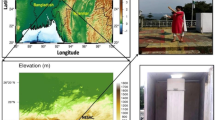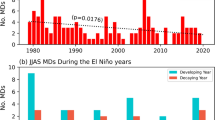Abstract
In this paper, daily variations of satellite-derived geophysical parameters such as integrated water vapour (IWV), cloud liquid water content (CLW), sea surface temperature (SST) and sea surface wind speed (SSW) have been studied for a case of monsoon depression that formed over the Bay of Bengal during 19th-24th August 2000. For this purpose, IRS P4 MSMR satellite data have been utilized over the domain equator — 25‡N and 40‡-100‡E. An integrated approach of satellite data obtained from IRS-P4, METEOSAT-5 and INSAT was made for getting a signal for the development of monsoon depression over the Indian region. Variations in deep convective activity obtained through visible, infrared and OLR data at 06 UTC was thoroughly analyzed for the complete life cycle of monsoon depression. Geophysical parameters obtained through IRS-P4 satellite data were compared with vorticity, convergence and divergence at 850 and 200 hPa levels generated through cloud motion vectors (CMVs) and water vapour wind vectors (WVWVs) obtained from METEOSAT-5 satellite. This comparison was made for finding proper consistency of geophysical parameters with dynamical aspects of major convective activity of the depression.
From the results of this study it is revealed that there was strengthening of sea surface winds to the south of low-pressure area prior to the formation of depression. This indicated the possibility of increase in cyclonic vorticity in the lower troposphere. Hence, wind field at 850 hPa with satellite input of CMVs in objective analysis of wind field using optimum interpolation (OI) scheme was computed. Maximum cyclonic vorticity field at 850 hPa was obtained in the region of depression just one day before its formation. Similarly, with the same procedure maximum anticyclonic vorticity was observed at 200 hPa with WVWVs input. Consistent convergence and divergence at 850 and 200 hPa was noticed with respect to these vorticities. In association with these developments, we could get lowest values of OLR (120 W/m2 ) associated with major convective activity that was consistent with the maximum values of integrated water vapour (6-8gm/cm2) and cloud liquid water content (50-60 mg/cm2 ) persisting particularly in the southwest sector of the monsoon depression.
Similar content being viewed by others
References
Ali M M and Collaborators 2000 Validation of multi-frequency scanning microwave radiometer geophysical data products;Pacific Ocean Remote Sensing Conference (PORSEC-2000) 182–191
Bhalme H N 1972 Trends and quasi-bionnial oscillation in the series of cyclonic disturbances over the Indian region;Indian J. Met. Geophys. 23 355–358
Eliot J 1884 Accounts of southwest monsoon storms generated in the Bay of Bengal during 1877-188;Mem. India Met. Dept. 2 217–448
Gohil B S, Mathur A K and Varma A K 2000 Geophysical parameter retrieval over global oceans from IRS-P4 MSMR;Pacific Ocean Remote Sensing Conference (PORSEC-2000) 207–211
Kamineni R, Rizvi S R H, Kar S C, Mohanti U C and Paliwal R K 2002 Assimilation of IRS-P4 (MSMR) meteorological data in the NCMRWF global data assimilation system;Proc. Indian Aca. Sci. (Earth Planet. Sci.) 111 351–364
Mahajan P N 2001 Utility of DMSP-SSM/I for integrated water vapour over the Indian seas;Proc. Indian Acad. Sci. (Earth Planet. Sci.) 110 225–229
Mahajan P N 2002a DMSP-SSM/I retrieval of proper surface winds during monsoon depression;Mausam 53 367–373
Mahajan P N 2002b Signal of weakening of tropical cyclone through multiple satellite approach;Tropmet 2002 (submitted for publication)
Mooley D A 1973 Some aspects of Indian monsoon depressions and associated rainfall;Mon. Weather Rev. 101 271–280
Pisharoty P R and Asnani G C 1957 Rainfall around monsoon depression over India;Indian J. Met. Geophys. 8 15–20
Rao K N and Jayaraman S 1958 A statistical study of frequency of depressions/cyclones in the Bay of Bengal;Indian J. Met. Geophys. 9 233–250
Sarkar R P and Chowdhury A 1988 A diagnostic structure of monsoon depressions;Mausam 39 9–18
Srinivasan V 1953 Variation of cyclonic circulation with height in September 1951 deep depression;Indian J. Met. Geophys. 4 263–264
Sikka D R 1977 Some aspects of life history, structure and movement of monsoon depression;Pure and Appl. Geophys. Basel 115 1501–1529
Varma A K, Gairola R M, Mathur A K, Gohil B S and Agarwal V K 2002 Intercomparison of IRS-P4 MSMR derived geophysical products;Proc. Indian Acad. Sci. 111 247–255
Author information
Authors and Affiliations
Rights and permissions
About this article
Cite this article
Mahajan, P.N., Khaladkar, R.M., Narkhedkar, S.G. et al. Proper depiction of monsoon depression through IRS-P4 MSMR. J Earth Syst Sci 113, 223–233 (2004). https://doi.org/10.1007/BF02709789
Received:
Revised:
Issue Date:
DOI: https://doi.org/10.1007/BF02709789




